#Opera di Santa Maria del Fiore
Text
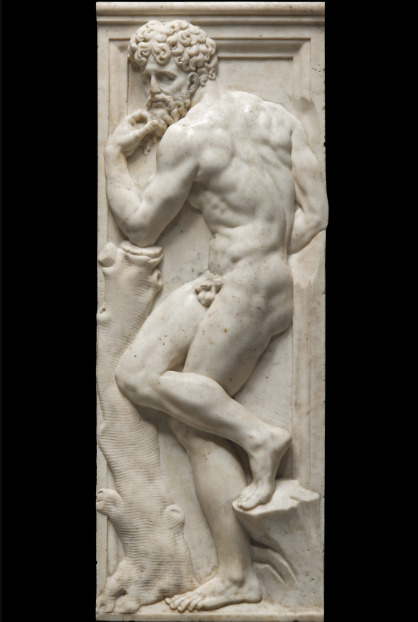



Details from the Coro Bandinelliano, Baccio Bandinelli and Giovanni dell'Opera, 1547-72
#art history#art#italian art#aesthethic#16th century#sculpture#marble#baccio bandinelli#coro bandinelliano#giovanni dell'opera#opera di santa maria del fiore#florence#firenze#bodybuilder#prophets#bible#rinascimento
32 notes
·
View notes
Text
RESTAURI / Giovanni Acuto e Niccolò da Tolentino, in condottieri alla "riconquista" di Firenze
#RESTAURI / Giovanni Acuto e Niccolò da Tolentino, in condottieri alla "riconquista" di #Firenze
Terminati i restauri dei due ritratti conservati in Duomo, opera di Paolo Uccello e Andrea del Castagno: ora sono di nuovo visibili al pubblico
Andrea del Castagno, monumento equestre a Niccolò da Tolentino, affresco, 1455, 833 x 512 cm, navata sinistra della Cattedrale di Firenze. COURTESY: Opera di Santa Maria del Fiore, foto Antonio Quattrone (particolare)
È terminato il restauro dei due magnifici affreschi di Paolo Uccello e Andrea del Castagno nel Duomo di Firenze che rappresentano i leggendari condottieri Giovanni Acuto e Niccolò…
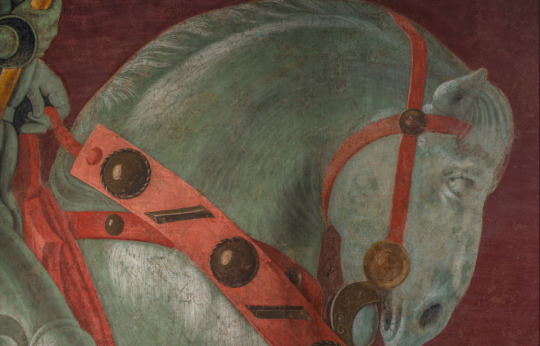
View On WordPress
#affreschi#Andrea del Castagno#Arte#Duomo di Firenze#firenze#Giovanni Acuto#Niccolò da Tolentino#Opera di Santa Maria del Fiore#Paolo Uccello#restauri#Rinascimento
2 notes
·
View notes
Text
Rodolfo Siviero il detective dell'arte.
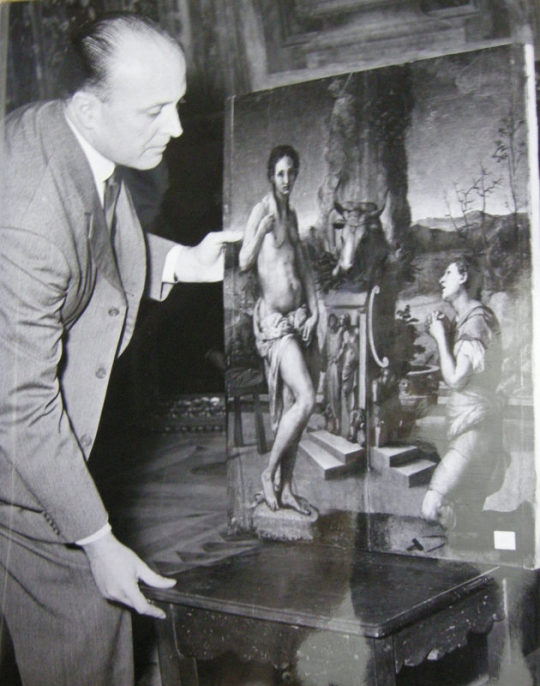
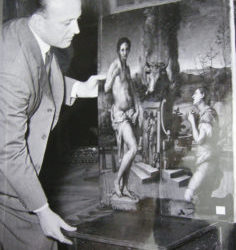
Rodolfo Siviero
Solitamente si ricorda un'opera d'arte o il suo creatore, l'artista, ma mai si ricorda chi quell'opera l'ha salvata. Esiste un personaggio di nascita pisana ma naturalizzato a Firenze che ha fatto del recupero di opere d'arte lo scopo della della sua vita. Il Signore in oggetto si chiamava Rodolfo Siviero e la sua base operativa esiste ancora sul Lungarno Serristori ed è possibile visitarla. Questo il link .
Siviero è appassionato d'arte sin da giovane e le sue frequentazioni di ambienti artistici e letterari gli permettono di crescere e migliorare la sua competenza in campo artistico, addirittura ha ambizioni poetiche, nel 1936 pubblica una raccolta di poesie "La selva oscura". La sua passione va dall'antico al moderno fino a scoprirsi critico d'arte.
In una fase iniziale aderisce al fascismo come molti giovani a quel tempo, ma è sufficiente poco tempo, e soprattutto la consapevolezza di quante opere d'arte vengono trafugate dall'Italia con la scusa di salvarle dai bombardamenti, per diventare un fervido antifascista. Si rende conto che queste opere finiscono nelle collezioni private dei gerarchi nazisti con il placido silenzio del fascismo italiano, tanto che dopo l'8 settembre del 1943 e l'occupazione tedesca in Italia il trasporto delle opere d'arte in Germania diventa un vero e proprio furto legalizzato continuativo.
Con base logistica all'interno della palazzina oggi conosciuta come Casa Siviero comincia il suo lavoro da antifascista sia mediante collegamenti con i partigiani sia mediante collegamenti con le truppe dell'intelligence inglesi. Il suo lavoro si svolge soprattutto nel segnalare, per poter essere intercettati, i convogli che trafugano verso la Germania le opere d'arte. Il suo lavoro non passa però inosservato e nell'aprile del 1944 vine catturato, imprigionato e torturato presso Villa Triste di via Bolognese, poi rilasciato grazie ad ufficiali collaboranti con le forze anglo-americane.
Questa sua conoscenza dell'arte e la sua attività serrata nel bloccare le "esportazioni" gli valgono, dopo la liberazione, incarichi di prestigio proprio a fronte del problema della restituzione delle opere d'arte trafugate prima e dopo la guerra, tanto da essere incaricato da De Gasperi nel 1953 per concludere un accordo con la Germania per la restituzione di tutte le opere d'arte ritrovate in suolo germanico. Tutti gli anni seguenti sono passati da Siviero come detective per ritrovare i tesori Italiani e riportarli in patria. Arriva a formare un ufficio preposto che con una fitta rete di informatori e la diplomazia riesce a scovare e recuperare innumerevoli pezzi d'arte.
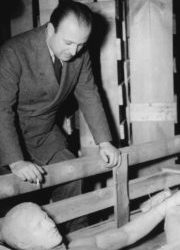
Roberto Siviero
Ricordiamo il Discobolo Lancellotti, i capolavori dei musei napoletani portati via dall'Abbazia di Montecassino o ancora le Fatiche di Ercole di Antonio del Pollaiolo conservate ora agli Uffizi e poi ancora Annunciazione del Beato Angelico.
Opera sua è il salvataggio dei quadri di De Chirico sottraendoli con stratagemma dalla villa di Fiesole dello stesso De Chirico costretto a scappare per rastrellamenti nazisti. Tutti i dipinti vengono nascosti in un deposito della Soprintendenza.
Le sue segnalazione permettono di intercettare e recuperare le opere d'arte trafugate a Firenze dalla Galleria degli Uffizi e dal Museo dell'Opera di Santa Maria del Fiore. Addirittura la Madonna con Bambino del Masaccio riesce a recuperarla due volte, prima nel 1947 e poi nel 1973 dopo il suo furto avvenuto 1971.
Negli ultimi anni della sua vita ricopre il ruolo di presidente della Accademia delle Arti del Disegno l'istituzione fiorentina fondata da Vasari e da Cosimo I dei Medici ma non smette mai il suo ruolo di "cercatore" anche se non più supportato dai successivi governi italiani come nei primi anni. Muore nel 1983 lasciando la sua collezione privata e la sua casa alla Regione Toscana perchè rimanga esempio di quanto siano importanti l'arte e la cultura nell'identificazione culturale di un popolo.
Oggi è possibile visitare il piano inferiore di Casa Siviero, un viaggio all'interno di un'abitazione privata aperta al pubblico circondati di oggetti e mobili pregiati senza contare i quadri appesi che vanno da De Chirico a Pietro Annigoni.

Jacopo Cioni
Read the full article
2 notes
·
View notes
Photo

🇮🇹Scorci fiorentini 🇬🇧Florentine glimpses . . . . . . #michelangelobuonarrotietornato #michelangelo #Michelangelobuonarroti #brunelleschi #storytelling #madeinitaly #artepertutti #arthistory #antoniettabandelloni (presso Opera di Santa Maria del Fiore) https://www.instagram.com/p/CiIYtIcDJ5_/?igshid=NGJjMDIxMWI=
#michelangelobuonarrotietornato#michelangelo#michelangelobuonarroti#brunelleschi#storytelling#madeinitaly#artepertutti#arthistory#antoniettabandelloni
2 notes
·
View notes
Text
Florentine Masterpiece: Piazza Del Duomo
The Piazza del Duomo, or Cathedral Square, is a famous and magnificent square located in the heart of Florence, Italy. It is considered one of the most beautiful and important squares in the city and is home to several architectural masterpieces.
The centerpiece of the Piazza del Duomo is the Florence Cathedral, also known as the Duomo di Firenze or cathedral of Santa Maria del Fiore. This iconic cathedral is a masterpiece of Italian Gothic architecture and features a distinctive dome designed by Filippo Brunelleschi. The dome, known as the Brunelleschi Dome, is one of the largest masonry domes in the world and is a symbol of the city of Florence duomo tour.
Adjacent to the cathedral is the Giotto's Campanile, a freestanding bell tower that is part of the Florence Cathedral complex. Designed by Giotto di Bondone, a renowned Florentine artist and architect, the Campanile is a beautiful example of Gothic architecture and is adorned with intricate sculptures and marble panels.
Another notable building on the square is the Baptistery of St. John, or the Battistero di San Giovanni. It is one of the oldest buildings in Florence and is renowned for its stunning bronze doors, including the famous Gates of Paradise by Lorenzo Ghiberti. The Baptistery features a mix of Romanesque and Gothic architectural styles and is an important site for religious ceremonies.
The Piazza del Duomo also features other notable structures, such as the Opera del Duomo Museum, which houses a collection of artworks and sculptures from the Florence Cathedral complex. Additionally, the square is surrounded by historic buildings, shops, and cafés, creating a vibrant and bustling atmosphere.
Overall, the Piazza del Duomo is not only a center of religious significance but also a testament to the artistic and architectural prowess of Florence. Its collection of magnificent buildings and sculptures make it a true masterpiece of the Florentine Renaissance.
0 notes
Text
0 notes
Text
Debutto italiano di Cordelia Williams, la pianista inglese a Pesaro il 2 luglio per WunderKammer Orchestra
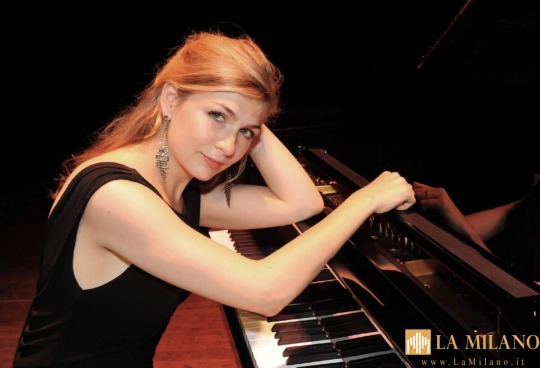
Debutto italiano di Cordelia Williams, la pianista inglese a Pesaro il 2 luglio per WunderKammer Orchestra.
WunderKammer Estate 2023: proposta estiva della WunderKammer Orchestra (WKO), parte con un debutto nazionale. Cordelia Williams, una delle più straordinarie pianiste della sua generazione, si esibirà per la prima volta in Italia a Pesaro, al cortile di Palazzo Montani Antaldi, domenica 2 luglio alle 21.30.
Riconosciuta per la poesia, la convinzione e la forza interiore del suo modo di suonare e per la profondità delle sue interpretazioni, la Williams a 17 anni è stata, nel 2006, giovane pianista dell'anno BBC, riconoscimento dell’emittente inglese assegnato per l’eccezionale talento musicale. Si è esibita in tutto il mondo tra Europa, America e Asia e trasmette regolarmente per BBC Radio 3. È particolarmente nota per la sua straordinaria comprensione e interpretazione della musica di Schubert e Schumann che, insieme a Brahms, costituiscono gli autori del programma che propone a Pesaro.
Il concerto si apre con le Waldszenen (Scene di foresta), op. 82, Nove pezzi per pianoforte di Robert Schumann che l’autore compone nel 1849. Il 1848 aveva visto fallire in tutt'Europa il sogno rivoluzionario e Schumann si rifugia in un mondo che si rifà natura, fantastico e irrazionale. Le Waldszenen sono una raccolta di nove pezzi brevi, ognuno dei quali evoca una scena della foresta, un fiore solitario, un cacciatore. La Williams ha dichiarato di sentirsi molto vicina a Schumann per “l’emotività, il dramma e i forti sentimenti intrappolati dentro di lui”.
A seguire i Tre Intermezzi, op. 117 di Johannes Brahms. Brahms profetizza in musica l’uomo del ventesimo secolo e nel 1892 compone tre intermezzi per pianoforte, recuperando le forme classiche da cui la prima generazione romantica si era con grande fatica emancipata. Occorreranno anni alla critica musicale per rendersi conto di quanto progressista fosse questo suo recupero, un ultimo rifugio dato all’uomo impietrito di fronte a un mondo che si sgretola, al crollo di ogni certezza.
Si chiude con la Sonata in do minore D 958 di Franz Schubert, composta nel 1828 a tre mesi dalla scomparsa del compositore per febbre tifoidea. Davanti alla morte Schubert recupera una scrittura semplicissima, un senso di quiete ieratica. Scrive Schumann a riguardo: “Queste sonate mi sembrano spiccatamente differenti dalle altre sue . Corre avanti di pagina in pagina sempre musicale e ricco di canto, interrotto qua e là da singoli sentimenti violenti ma che presto si calmano nuovamente”. “La musica di Schubert - per la Williams - ha un'anima romantica che cerca di uscire da un corpo classico, una qualità e una sottigliezza luccicanti che non puoi afferrare facilmente e una malinconia con cui mi connetto davvero”.
WunderKammer Estate 2023 è realizzata con il Patrocinio del Comune di Pesaro, la collaborazione di Cantiere Internazionale d’Arte di Montepulciano, Macerata Opera Festival 2023, Fondazione Cassa di Risparmio di Pesaro, che WKO ringrazia per aver messo a disposizione Cortile e Auditorium di Palazzo Montani Antaldi, e Amat; il sostegno di Sistemi Klein, Giardino di Santa Maria, Ceramiche Bucci, Roberto Valli Pianoforti.
Biglietti:
Intero € 20,00; Ridotto soci WKO € 15,00; Under 26 € 5,00; Under 12 € 1,00.
Acquisto, online sui canali Vivaticket e nelle biglietterie del circuito AMAT/Vivaticket; Biglietteria Teatro Sperimentale dal mercoledì al sabato dalle 17 alle 19; Tipico.Tips negli orari di apertura dell’esercizio; presso Palazzo Montani Antaldi un’ora prima dell’inizio del concerto....
#notizie #news #breakingnews #cronaca #politica #eventi #sport #moda
Read the full article
0 notes
Text
Filippo Brunelleschi
Filippo Brunelleschi è stato un celebre architetto e ingegnere italiano del Rinascimento. Nato nel 1377 a Firenze, è conosciuto principalmente per la sua opera più famosa, la cupola della cattedrale di Santa Maria del Fiore, detta il Duomo di Firenze. Brunelleschi fu uno dei primi a introdurre principi matematici e prospettici nell'architettura, utilizzando tecniche innovative per realizzare strutture di grande stabilità e bellezza. La sua visione e la sua maestria nell'ingegneria gli permisero di realizzare opere che ancora oggi sono ammirate per la loro grandiosità e per la loro armonia. Brunelleschi morì nel 1446, ma il suo lascito nell'architettura e nell'ingegneria continua a influenzare e ispirare gli artisti e gli architetti di tutto il mondo.
0 notes
Text
The seven day we woke up very early to walk and go to the Uffizi Gallery the place that I think is has ones of the most famous peace’s of art in the whole world. There we saw so much art that I have never seen before. There we saw for examples the birth of Venus, another is the head of Medusa. That paintings are paintings that I have waited my hole life to see them in person now my hole family wants to go over there to Italy and see them in person because there memories that I am going to have in my head my hole life, After the Uffizi we had free time and we went to the opera di Santa Maria del Fiore it was like a museum after that we went up to the Giotto Campanile and we saw one of the best views in Florence. After that I went to Forte di belvedere it was a little late so I couldn’t get in. After that it was night so we walk through the city of Florence and there where a lot of people on the strits so we stay out for a long time and had fun that was my first time eating kebab it was great.

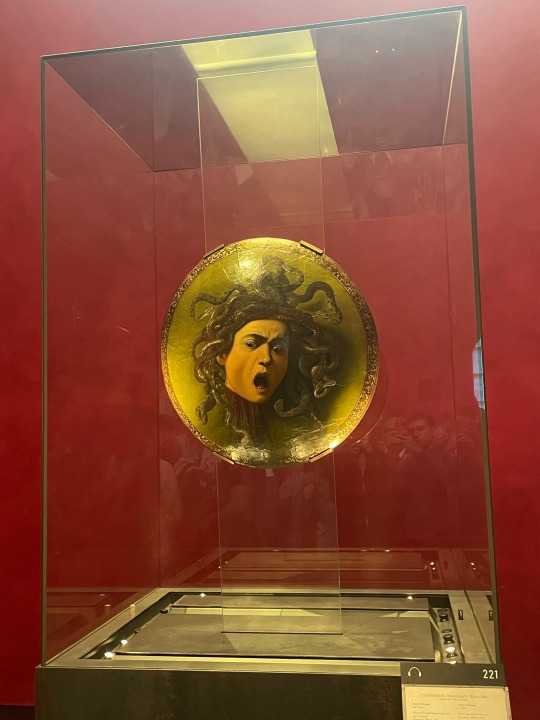

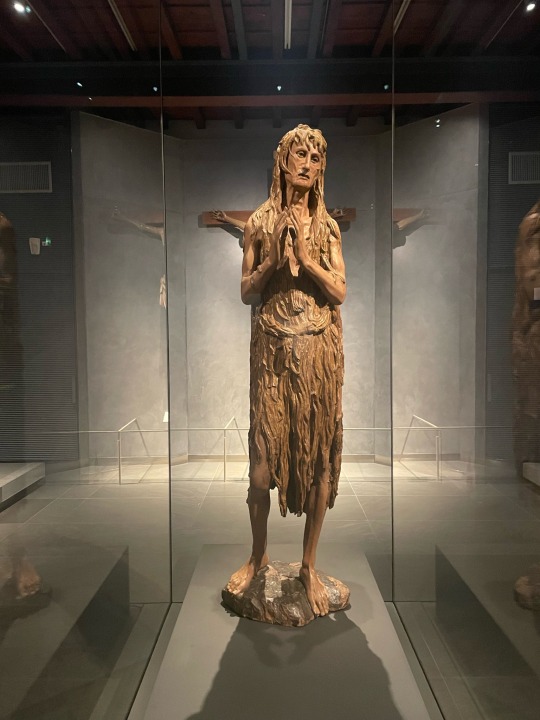
1 note
·
View note
Text
"Museo Opera del Duomo di Firenze"
“Italia, la meraviglia in cui siamo immersi”Cattedrale di Santa Maria del Fiore, Duomo di Firenze……
“…la chiesa di Santa Maria del Fiore di Fiorenza. La quale fu una pianta bellissima di quella maniera, che fu di pietre forti squadrate di dentro tutta lavorata, e di fuori di marmi bianchi e neri e rossi incrostata e adorna (…) né in cristianità si truova fabrica moderna più ornata di quella,…
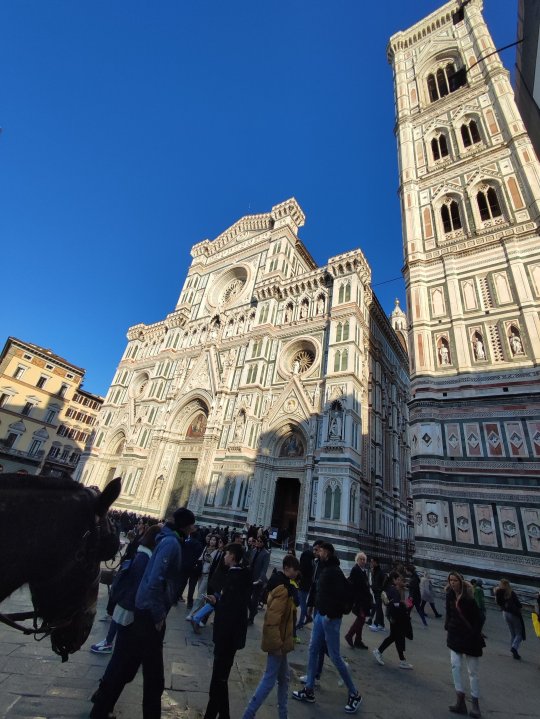
View On WordPress
0 notes
Text
RESTAURI / Sei anni per risplendere: al via l'intervento sui magnifici mosaici della cupola del Battistero di Firenze. Il cantiere sarà aperto al pubblico con visite guidate
#RESTAURI / Sei anni per risplendere: al via l'intervento sui magnifici mosaici della cupola del #Battistero di #Firenze. Il cantiere sarà aperto al pubblico con visite guidate
Dettagli, #Foto e #Video su Storie & Archeostorie

View On WordPress
#Battistero di Firenze#beni culturali#Duomo di Firenze#Medioevo#Opera di Santa Maria del Fiore#restauri
1 note
·
View note
Text
Andrea del Castagno, pittore
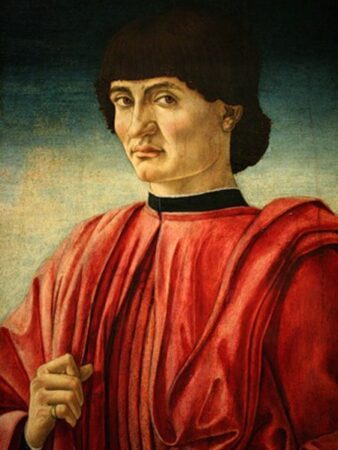

Andrea del Castagno è stato un grande pittore italiano, nacque nel 1419 in Toscana nell'Alto Mugello nel paese chiamato Castagno Comune di San Godenzo, di cui in seguito lo userà come cognome, facendosi conoscere come Andrea del Castagno. Era figlio di Bartolo di Simone di Bargilla e di Lagia. La famiglia viveva del loro lavoro di contadino.
In quel tempo vi furono le guerre fra Firenze e Milano, per l'egemonia del Nord Italia. Nel 1423 Firenze si alleò con la Repubblica di Venezia contro il Ducato di Milano per contrastare l'espansionismo dei Visconti. In seguito si unì con Francesco Sforza contro la crescente minaccia di Venezia.
Il pittore per non subire le scorrerie degli eserciti in lotta deve lasciare la sua terra trasferendosi nella fortezza di Belforte. Poterono ritornarci dopo la pace effimera del 1427.
E' stato uno dei protagonisti della pittura fiorentina del XV° secolo. Si trova annoverato insieme ad altri artisti presenti in quel tempo a Firenze: Giovanni da Fiesole detto "il Beato Angelico", Filippo Lippi, Domenico Veneziano e Paolo di Dono detto "Paolo Uccello". Il suo stile subì l'influenza di altri due grandi artisti Tommaso di Mone di Antonio Cassai detto "Masaccio" e Donato di Betto Bardi detto "Donatello". Da loro sviluppò la resa prospettica, il chiaroscuro, drammatizzato nei personaggi rappresentati.
Andrea arrivò a Firenze nel 1440 sotto la protezione di Bernardetto dè Medci esponente del ramo cadetto della famiglia Medici di Ottajano. E' conosciuto con il soprannome di Andrea degli impiccati, gli fu dato quando ebbe l'incarico di dipingere sulla facciata del Palazzo del Podestà l'immagine dei fuggiaschi Rinaldo degli Albizi e Ridolfo Peruzzi condannati per aver ordito una congiura contro Cosimo "il Vecchio" dè Medici.

Lavorò con Domenico Veneziano insieme a Piero della Francesca e altri assistenti, alla realizzazione degli affreschi andati perduti delle Storie della Vergine, che si trovavano nella chiesa di Sant'Egidio. Per lo Spedale di Santa Maria Nuova realizza una crocifissione e santi, dove nella sua opera si nota un influenza masaccesca.
Trasferitosi a Venezia realizza insieme a Francesco da Faenza nell'abside della cappella di San Tarasio, nella chiesa di San Zaccariali affreschi con Dio Padre, Santi e i quattro Evangelisti. Lavora anche nella Basilica di San Marco realizzando i cartoni per i mosaici con le storie della Vergine (Visitazione e morte della Vergine) negli anni 1442/1443.
Rientrato a Firenze lavora nel convento delle benedettine di Sant'Apollonia, fra (forse) il 1445 e il 1450, alle scene della passione di Cristo, la Crocifissione, la Deposizione dopo la morte, la resurrezione e l'Ultima Cena. Alcuni di questi affreschi sono stati staccati e conservati nel Museo a lui dedicato nel paese di Castagno Comune di San Godenzo. Gli affreschi rimasti nel luogo in cui sono stati realizzati, sono molto rovinati ma ancora leggibili.
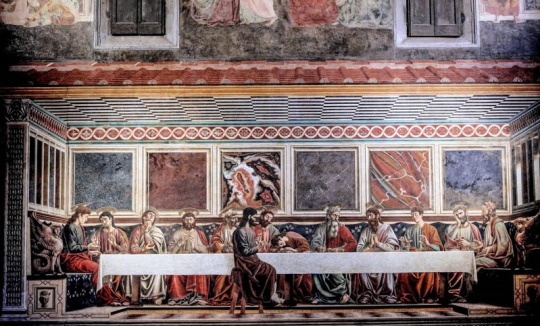
Per la villa del Gonfaloniere di Giustizia Filippo Carducci, dipinge ritratti di uomin e donne illustri. Molti sono stati staccati e conservati al Museo degli Uffizi, mentre altri sono rimasti alla villa. I ritratti sono: Madonna con Bambino Angeli e Adamo ed Eva, un altro di Eva, Davide con ai piedi la testa del gigante Golia e di Pippo Spano. Agli Uffizi è conservato un affresco rappresentante il Vate Dante Alighieri e la Madonna di casa Pazzi facente parte della collezione Contini Bonacossi.

Nel 1455 torna a lavorare per i frati Serviti, alla Basilica della Santissima Annunziata, dipinge degli affreschi con la Trinità, San Girolamo Due Sante San Giuliano e i Redentore. Nella Loggia dei Servi di Maria dove si trova l'Oratorio di San Francesco Poverino, per la confraternita di San Girolamo e San Francesco Poverino in San Filippo Benizi. Per la compagnia del Santo Benizi, realizza una statua in terracotta rappresentante San Girolamo.
Per i Duomo di Santa Maria del Fiore, dipinge un monumento equestre dedicato al Capitano della Repubblica nel 1432 durante la battaglia di San Romano Niccolò Mauruzi da Tolentino, accanto a quello dedicato al Capitano John Hawkwood detto "Giovanni Acuto" di Paolo Uccello.
Andrea del Castagno morì giovanissimo di peste il 19 agosto 1457 e sepolto nella Basilica della Santissima Annunziata. Il Vasari nel suo capolavoro "Vite" scrisse che Andrea del Castagno aveva ucciso il suo amico e maestro Domenico Veneziano in un impeto di gelosia, ma erano solo chiacchiere raccolte qua e la, con le quali screditò Andrea già morto quando nel 1461 morì Domenico. L'errore che smontò la falsa accusa venne scoperto tempo dopo, quando dai registri mortuari furono trovati un altro Andrea e un altro Domenico, protagonisti di quel delitto di cui era stato accusato l'Andrea pittore.

Alberto Chiarugi
Read the full article
0 notes
Text



Donatello’s David
Early into the renaissance the artist known as Donatello created a bronze sculpture of David, who was stated in the bible to have defeated Goliath a giant with just a slingshot. Even though David later went on to become a king, Donatello specifically chose to depict David in his youth and nude. Perhaps as a way to send a message about innocence. Donatello’s bronze statue of David may be one of his more known works, but Donatello also did another depiction of David this time instead of bronze the statue was constructed through marble. Donatello made this second depiction around 1408 - 1409. This statue of David also had small differences, not only in the sense that it was created out of different materials, but the marble statue was also slightly taller, the bronze version held Goliath's sword as a symbol of victory, while the marble version does not possess a sword. We also see in the bronze version the statue has some sort of helmet while the marble version does not have the helmet, lastly the most notable difference between these creations the marble statue was clothed in robes, while the bronze statue had little to no covering. There is also symbolism embedded within the sculptures, the main focus being courage and bravery. In David and Goliath’s fable you would have never expected David to defeat Goliath in battle, but even with the odds stacked against him, David stood tall and stepped up to the challenge and ultimately brought down Goliath. The way this victory is expressed within the sculptures both statues have their foot propped up on Goliath’s severed head. Though the focus was on Donatello there were also other artists who’ve depicted David, such as Michelangelo, Domenico Ghirlandaio's, Verrocchio's, Antonio del Pollaiuolo's, and Gian Lorenzo Bernini. You can find both sculptures in the Museo Nazionale del Bargello in Florence, Italy.
David by Donatello (thehistoryofart.org)
Donatello’s David – ItalianRenaissance.org
Santa Maria del Fiore
The Santa Maria del Fiore is a church that began construction in the 14th century and was later completed in the 15th century, Santa Maria del Fiore is the third largest church in the whole world and the largest church within Europe. Florence was a city that was well and thriving because of their cloth trades, even bold enough to compare Florence to ancient Rome. The production of Santa Maria del Fiore was simply because the citizens wanted to be able to include all citizens into the church, at the moment they were only able to fit approximately 30,000 people at once inside of their church, the goal was to be able to fit 100,000 people in. Around 1296 up until 1302 which was then later completed in 1436, Arnolfo di Cambio was hired as the very first architect to work on Santa Maria del Fiore. The exterior of the church is made of encrusted Marble which is like homage to Tuscan Romanesque style of the revetment on the baptistery, it is also used in the Florentine church of San Miniato. Santa Maria del Fiore is known to be a symbol to Saint Mary of the Flower, the flower being Christ himself. A typical difference between Santa Maria del Fiore and gothic churches was the size of the windows, the windows within Santa Maria del Fiore were notably smaller than the windows you’d find in a gothic church, though the part of the church that was important wouldn’t be added until later. As new builders arrived on the scene to help with the construction of Santa Maria del Fiore they were confused on how to complete the dome to the massive church, ultimately they gave up believing that the ingenuity of the future would somehow accept the challenge and complete the process. Fortunately in 1425, Filippo Brunelleschi came along with a plan to complete the domes which he did successfully.
Cathedral of Santa Maria del Fiore – ItalianRenaissance.org
The Cathedral of Santa Maria del Fiore | The Opera del Duomo
The Papal Palace at Avignon
The city of Popes, Avignon, the papal palace is claimed to be one of the most well defended home in the entire world. Beginning back in 1335 the palace was a joint creation of two popes Benedict XII, and his successor Clement VI. Both popes were known for building parts of the palace from North to East Benedict XII built the old palace, while his successor Clement VI built South and West of the new palace, it took a total of 18 years to complete. The palace stretched over 15,000 square feet with both the exterior and interior of the palace being beautifully decorated since no expenses were spared. Around the 15th century there was a major decline because the Pope’s palace essentially became surplus, no one cared for the palace at all leaving it subjected to vandalism and other acts of poor treatment. The palace would then later be used as a military prison after the French Revolution. Finally the palace would soon return to its former glory at the start of the 20th century where people began to realize and understand the palace's importance.
Popes Palace in Avignon: history and visitor information (francethisway.com)
Historic Centre of Avignon: Papal Palace, Episcopal Ensemble and Avignon Bridge - UNESCO World Heritage Centre
Hundred Years’ War (1337 – 1453)
The battle between England and France that lasted over 100 years, a dispute over who would take the French crown. Starting off in the 14th century, France was wealthy and powerful, and was known to be the most populated kingdom in Western Europe. But because England was best organized and closely integrated with Western Europe and the state most likely to rival France, conflict was inevitable. During the period of the conflict French kings were steadily weakening the Angevin Empire, it was this struggle that was termed the "First Hundred Years' War". Which was ended because of a treaty between Henry III of England and Louis IX of France.
Hundred Years’ War - HISTORY
Hundred Years’ War | Summary, Causes, Effects, Combatants, Timeline, & Facts | Britannica
THE EUROPEAN RENAISSANCE
Urban growth, wars of expansion, humanism, growth of literacy, language and eloquence, all things that made the renaissance great. Around the 11th century there was an upsurge in population, at the same time towers, and old towns were being revived. One of the main causes of the renaissance was because of the Fall of Constantinople, where the Byzantine Empire was captured by the Ottoman Empire, it was a 53 day siege that began 6 April 1453, and came to an end on 29 May 1453. Because the Fall of Constantinople led to the renaissance becoming a center of learning where Greek scholars taught literature and language to others. Because of the Renaissance, a lot of architecture was heavily influenced. A plethora of churches, gigantic buildings, and palaces constructed in the style of ancient Greece and Rome. Painting artists of Italy during the Renaissance were extremely skilled and went on to become some of the most famous painters in the world such as Leonardo-da-Vinci who has become a legendary name for his most famous painting "The Monalisa ''. Another world renowned painter was Michelangelo, but Michelangelo not only held expertise in painting but in sculpting, architecture, poet, and an engineer. Not only did fine arts, and language and towns improve during the Renaissance, but science also advanced, there were developments in astrology, and medicine. Amazing scientists emerged such as Galileo, Galileo was a lecturer of mathematics in the University of Pisa where he became a professor. Galileo would go on to invent the telescope where he proved the theory of Copernicus was true. The theory of Copernicus was about planetary motion. Renaissance meaning rebirth truly lived up to its name, it was a time where Europeans essentially reinvented themselves from the ground up, ushering in an era of improvements on fine arts, science, architecture, it was an absolute pivotal time in period for them.
Renaissance in Europe: Meaning, Causes and Results of Renaissance (historydiscussion.net)
history of Europe - The Renaissance | Britannica
1 note
·
View note
Text
Most Visited Attractions in Italy
Italy – the birthplace of the Renaissance and the Roman empire is a treasure trove of art, architecture, and history. Italy has the most UNESCO-listed cultural sites than any other country with a vast number of masterpieces by some of the most gifted artists to have ever lived.
You might arrange a whole tour around a single interest, such as art or camping, but we're here to give the first-time visitors a glimpse of the best of what Italy has to offer.
The Florence Duomo
The Duomo Cathedral of Florence, also known as the Cattedrale Di Santa Maria Del Fiore, was one of the most important architectural structures in 14th-century Florence. It brought a new era of art and engineering to Italy.
Take a walk in the Piazza Del Duomo and admire the centuries of art all around you, or a guided tour through the Florence Cathedral, the Baptistry, the opera theatre, Brunelleschi's Dome, the cathedral bell tower, and the Santa Reparata Crypt. You can climb to the top of the dome and be awed by an intimate view of the stunning fresco “The Last Judgement”.
The Colosseum
The Colosseum is a Roman icon, one of the ancient world's seven wonders and a stunning example of ancient Roman architecture.
The Flavian Amphitheater (the nick-name Colosseum came much later) was built on Emperor Vespasian's whim between 70 and 80 AD. A modern-day football pitch could easily fit within this old sports facility. Nearly four centuries of blood-sport were observed on the Colosseum Arena floor. The Colosseum hosted gladiatorial contests and public shows including as animal hunts, simulated sea warfare, re-enactments of popular battles, executions, and tragedies. It stands as a reminder of the Roman Empire’s might and wealth.
The Vatican City
The Vatican – the holy city is home to some of the most valuable art and art collections in the world. The vast Basilica of St. Peter, which houses St. Peter's grave, and one of Michelangelo's most moving works, the Pieta, is the focal point and a tour of the Vatican City is a must for the pious at least once in your life.
Watch the Pope address the people at the St. Peter’s Square and witness Michelangelo's frescoes on the walls and ceilings of the Sistine Chapel, and works by Raphael and other great artists in the Vatican Palace. You can be a devout pilgrim or a lover of art and the artists, a tour of the holy city should be on your bucket list.
Cinque Terra
Cinque Terre is a beautiful seaside region with high hills and sharp cliffs that gaze out over the Mediterranean. The villages in the region are connected by walking trails, a railroad that burrows through the headlands to emerge at each town, or a spectacular tiny road high on the slope above. If you're a nature lover, an adventurer, or into camping and hiking then this is the place for you.
Hike between the villages that still retain that old-world charm of a fishing village and enjoy the terrific scenic beauty far away from the hustle and bustle of the city that Cinque Terre provides.
Pompeii & Mount Vesuvius
Book a tour of the ruins of Pompeii and look at the still smoldering Mt. Vesuvius, which looks over the city it destroyed thousands of years ago. You get the chance to view the frescoes, mosaics, and sculptures that were encased in lava since the eruption.
Witness the remains of houses, markets, baths, temples, theaters, streets, and human bones discovered. You can take a tour of the site, stroll over old alleys scarred by chariot tracks, and view Roman engineering from over 2,000 years ago. Is there a better way to let your inner explorer out than while exploring the ruins of Pompeii?
As a bonus, you can also combine a tour of Pompeii with that of another excavated city- Herculaneum, which was destroyed by the same eruption but was buried in lava and ash that consolidated the town exactly the way it was.
Milan Duomo
The Duomo in Milan is without a doubt the city's most beautiful edifice. This massive Gothic church, which stands tall in Piazza del Duomo, has seen more than 600 years pass by, as evidenced by its history and architecture.
With its magnificent Gothic architecture, stained-glass windows, and tapestries, it is one of Italy's and Europe's largest cathedrals. Climb to the rooftop, 150 feet above street level, for a panoramic view of the city, which is ornamented with white marble spires in different rows. Don't miss the opportunity to go below under the foundation of the Basilica di Santa Tecla and the Baptistry.
0 notes
Text
Tour of the Duomo Florence
The Duomo, officially known as the Florence Cathedral or Cattedrale di Santa Maria del Fiore, is one of the most iconic landmarks in Florence, Italy. It's a magnificent example of Gothic architecture and attracts millions of visitors each year. If you're planning a tour of the Duomo, here's a suggested itinerary:
Duomo Square (Piazza del Duomo): Start your tour at the Duomo Square, which is the main entrance to the cathedral. Take some time to admire the square's grandeur and soak in the atmosphere.
Giotto's Campanile: Adjacent to the cathedral, you'll find Giotto's Campanile, a bell tower that offers stunning panoramic views of Florence. Climb the 414 steps to the top for a breathtaking vista of the city.
The Baptistery of San Giovanni: Located right in front of the cathedral, the Baptistery is an octagonal building renowned for its beautiful bronze doors, including the famous Gates of Paradise by Lorenzo Ghiberti. Step inside to see the intricate mosaics and the stunning ceiling.
Florence Cathedral (Il Duomo): Enter the cathedral itself and prepare to be amazed by its vast interior. Marvel at the impressive nave, stunning stained glass windows, and the iconic dome designed by Filippo Brunelleschi. Take your time to explore the various chapels and works of art housed within.
Dome Climb (Cupola): If you're up for a physical challenge, climb to the top of the dome. The climb involves ascending a narrow staircase with 463 steps, but the reward is well worth it. Enjoy panoramic views of Florence and take a close-up look at the frescoes adorning the inner surface of the dome.
The Crypt of Santa Reparata: Beneath the cathedral, you'll find the archaeological site of the original cathedral of Florence, Santa Reparata. Explore the underground space and discover the remnants of an ancient basilica.
Opera del Duomo Museum: To delve deeper into the history and art associated with the Duomo, visit the Opera del Duomo Museum. It houses an extensive collection of sculptures, including works by Donatello and Michelangelo, as well as original artworks from the cathedral's exterior.
Galleria dell'Accademia: Although not directly part of the Duomo complex, the Galleria dell'Accademia is worth a visit if you have time. It is home to Michelangelo's famous sculpture, David, along with other Renaissance masterpieces.
Note: It's important to check the current opening hours, ticket availability, and any specific entry requirements before your visit, as they may be subject to change. It's also advisable to book tickets in advance to avoid long queues, especially during peak tourist seasons.
0 notes
Text
Most Visited attractions in Italy
Italy – the birthplace of the Renaissance and the Roman empire is a treasure trove of art, architecture, and history. Italy has the most UNESCO-listed cultural sites than any other country with a vast number of masterpieces by some of the most gifted artists to have ever lived.
You might arrange a whole tour around a single interest, such as art or camping, but we're here to give the first-time visitors a glimpse of the best of what Italy has to offer.
The Florence Duomo
The Duomo Cathedral of Florence, also known as the Cattedrale Di Santa Maria Del Fiore, was one of the most important architectural structures in 14th-century Florence. It brought a new era of art and engineering to Italy.
Take a walk in the Piazza Del Duomo and admire the centuries of art all around you, or a guided tour through the Florence Cathedral, the Baptistry, the opera theatre, Brunelleschi's Dome, the cathedral bell tower, and the Santa Reparata Crypt. You can climb to the top of the dome and be awed by an intimate view of the stunning fresco “The Last Judgement”.
The Colosseum
The Colosseum is a Roman icon, one of the ancient world's seven wonders and a stunning example of ancient Roman architecture.
The Flavian Amphitheater (the nick-name Colosseum came much later) was built on Emperor Vespasian's whim between 70 and 80 AD. A modern-day football pitch could easily fit within this old sports facility. Nearly four centuries of blood-sport were observed on the Colosseum Arena floor. The Colosseum hosted gladiatorial contests and public shows including as animal hunts, simulated sea warfare, re-enactments of popular battles, executions, and tragedies. It stands as a reminder of the Roman Empire’s might and wealth.
The Vatican City
The Vatican – the holy city is home to some of the most valuable art and art collections in the world. The vast Basilica of St. Peter, which houses St. Peter's grave, and one of Michelangelo's most moving works, the Pieta, is the focal point and a tour of the Vatican City is a must for the pious at least once in your life.
Watch the Pope address the people at the St. Peter’s Square and witness Michelangelo's frescoes on the walls and ceilings of the Sistine Chapel, and works by Raphael and other great artists in the Vatican Palace. You can be a devout pilgrim or a lover of art and the artists, a tour of the holy city should be on your bucket list.
Cinque Terra
Cinque Terre is a beautiful seaside region with high hills and sharp cliffs that gaze out over the Mediterranean. The villages in the region are connected by walking trails, a railroad that burrows through the headlands to emerge at each town, or a spectacular tiny road high on the slope above. If you're a nature lover, an adventurer, or into camping and hiking then this is the place for you.
Hike between the villages that still retain that old-world charm of a fishing village and enjoy the terrific scenic beauty far away from the hustle and bustle of the city that Cinque Terre provides.
Pompeii & Mount Vesuvius
Book a tour of the ruins of Pompeii and look at the still smoldering Mt. Vesuvius, which looks over the city it destroyed thousands of years ago. You get the chance to view the frescoes, mosaics, and sculptures that were encased in lava since the eruption.
Witness the remains of houses, markets, baths, temples, theaters, streets, and human bones discovered. You can take a tour of the site, stroll over old alleys scarred by chariot tracks, and view Roman engineering from over 2,000 years ago. Is there a better way to let your inner explorer out than while exploring the ruins of Pompeii?
As a bonus, you can also combine a tour of Pompeii with that of another excavated city- Herculaneum, which was destroyed by the same eruption but was buried in lava and ash that consolidated the town exactly the way it was.
Milan Duomo
The Duomo in Milan is without a doubt the city's most beautiful edifice. This massive Gothic church, which stands tall in Piazza del Duomo, has seen more than 600 years pass by, as evidenced by its history and architecture.
With its magnificent Gothic architecture, stained-glass windows, and tapestries, it is one of Italy's and Europe's largest cathedrals. Climb to the rooftop, 150 feet above street level, for a panoramic view of the city, which is ornamented with white marble spires in different rows. Don't miss the opportunity to go below under the foundation of the Basilica di Santa Tecla and the Baptistry.
1 note
·
View note